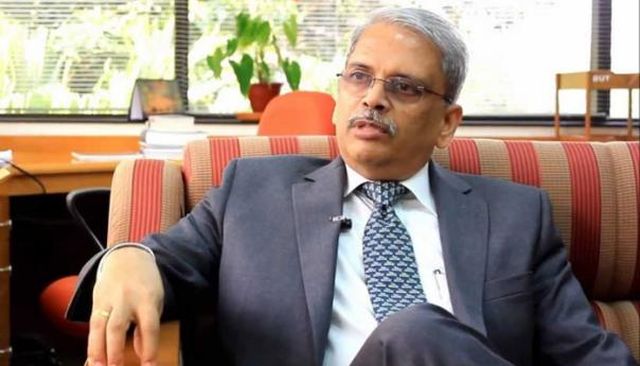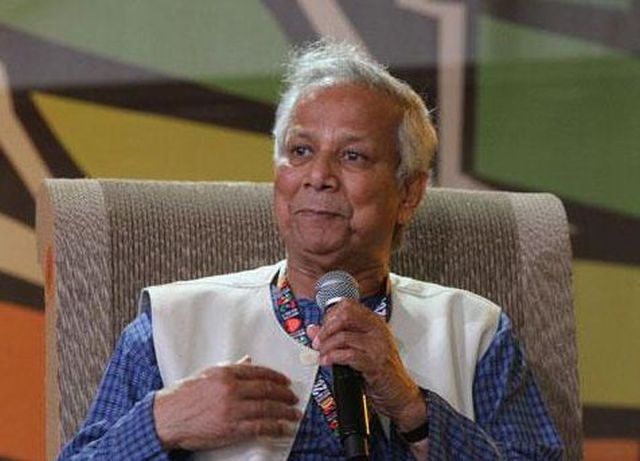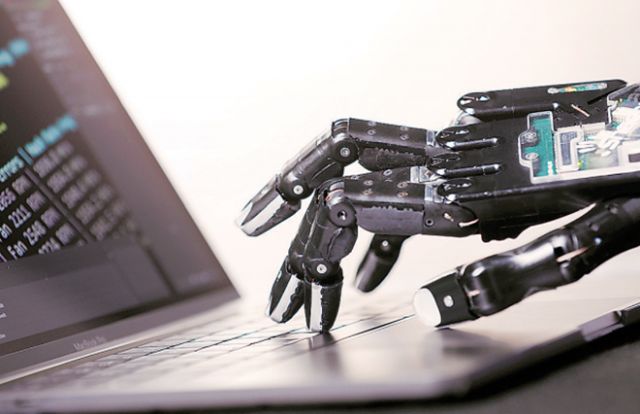
by Editor | May 25, 2021 | Interviews

Infosys co-founder Kris Gopalakrishnan
By Bhavana Akella,
Bengaluru : With new technologies disrupting businesses and changing the rules of engagement, India faces a daunting task to reskill its huge workforce for Artificial Intelligence (AI), Infosys co-founder Kris Gopalakrishnan says.
“India has a major challenge of transitioning its young workforce to the fourth industrial revolution called AI after the eras of agriculture, manufacturing and services,” Gopalakrishnan told IANS in an interview here.
Gopalakrishnan, 63, well-known as ‘Kris’, is one of the seven co-founders of the iconic IT firm, who became its chief executive after fellow co-founder Nandan Nilekani quit in mid-2009 to set up the Unique Identification Authority of India (UIDAI) for issuing Aadhaar cards to over a billion citizens.
“As the large workforce is engaged in diverse occupations such as agriculture, manufacturing and white-collar jobs in the services sector, it needs to be re-skilled to sustain the jobs, as AI will replace traditional jobs,” said Gopalakrishnan.
Originating in the mid-1950s as an academic discipline, AI involves machines emulating human intelligence. Many experts like American aerospace firm SpaceX founder Elon Musk and renowned astrophysicist Stephen Hawking, however, feared that AI would spell doom by replacing humans as thinking machines.
As a geek, Gopalakrishnan allayed unknown fears of AI, terming it as a transition none can avoid but adopt in due course.
“AI is a transition that is bound to happen, whether we like it or not. We should rather think of preparing the workforce for it by reskilling it. We have to brace for skilled jobs, as many conventional jobs will be lost though many more will be created in allied areas,” he pointed out.
Golalakrishnan, however, refused to answer any questions on Infosys’ developments in the field of AI, even as the software giant has been working on the technology through its platforms like Nia over the past few years.
Though use of robots in the automobile industry led to the loss of painting jobs in assembly lines of car plants, Gopalakrishnan said on the flip side, they saved the blue-collar workforce from the harmful exposure to chemical paints.
Hawking (1942-2018), had termed the emergence of AI as the worst event in the history of civilisation and urged its propounders to find ways to control its development.
Participating in a web summit technology conference at Lisbon in Portugal on November 6, 2017, Hawking said computers could, in theory, exceed human intelligence (HI).
“Unless we learn how to prepare for, and avoid, the potential risks, AI could be the worst event in the history of our civilisation. It brings dangers, like powerful autonomous weapons, or new ways for the few to oppress the many. It could bring great disruption to our economy,” Hawking asserted.
Echoing Hawking, Telsa co-founder Musk charged that AI was more dangerous than nuclear warheads and called for a regulatory authority to oversee its development as super intelligence.
“The biggest issue I see with so-called AI experts is they think they know more than they do, and they think they are smarter than they actually are,” said Musk at a tech conference at Austin in Texas on March 12, as reported in the US media.
Countering the likes of Hawking and Musk, Gopalakrishnan said there was no simple solution with disruptive technologies but to adopt them to sustain and thrive.
“If we don’t prepare as a country to re-skill our people for an AI-led future, there will be social unrest because their jobs will become redundant,” he reiterated.
Unfazed by partial opposition to AI, Gopalakrishnan was passionate about AI for the immense benefits he saw in it.
“As in every technology, risks are inherent even in AI, though I see a bright future in its adoption. Through AI in key areas like healthcare, we can reduce the cost of technology to improve the quality of life,” he affirmed.
Key sectors such as health, education and transportation will be impacted by AI, with machine intelligence reducing labour and redundant activities.
“AI is reaching the critical stage of consumerisation, becoming a technology for our daily use. It can create opportunities to spur growth,” Gopalakrishnan claimed.
In this context, Gopalakrishnan, chairman of India Inc apex body CII’s innovation cell, clarified that the industry, academia and the government have to share the responsibility of getting the workforce prepared for AI-led jobs.
“The preparedness should begin with training undergraduate students on AI by including it in their courses,” he added.
In a technology-driven world, Gopalakrishnan said India’s policies have to strike a balance between protecting an individual’s privacy and promoting the tech medium.
(Bhavana Akella can be contacted at bhavana.a@ians.in)
—IANS

by Editor | May 25, 2021 | Business Summit, Entrepreneurship, Events, Markets, Social Entrepreneur, Technology

Nobel laureate Muhammad Yunus
Bengaluru : Expressing apprehension that disruptive technology would hasten extinction of humankind, Nobel laureate Muhammad Yunus on Thursday warned companies against excessive use of Artificial Intelligence (AI).
“Technology will expedite our extinction on the planet Earth. It may sound funny because technology is supposed to help us and make things easier. But the way AI is invading the world, it will soon replace us with machines to do our job,” Yunus said at the eighth edition of Social Business Day here.
The Bangladeshi won the Nobel Peace Prize in 2006 for his effort to fight poverty. Yunus founded Grameen Bank which gives microcredit to the poor without any collateral.
Organised by the Yunus Centre, a Dhaka, Bangaldesh-based think tank founded by Yunus himself, the event had participants from 42 countries including Afghanistan, Australia, Canada, Italy, France, Taiwan and the US, among others.
As human beings can be replaced with machines, thereby saving money, more machines are being made in the world, leading to widespread use of AI, Yunus pointed.
“With the production cost using machines going down and profit margin going up, more machines are being made.”
In the process of adopting AI, several people will be pushed out of the jobs they hold, Yunus warned.
“We already have nearly 30-40 per cent of the youth remaining unemployed in several prosperous economies. And with the AI, people who are employed won’t have their jobs as smart machines are taking over,” the Nobel laureate said.
Technology, while being a blessing also has the potential to leave a human being at the mercy of others, creating a whole community of “beggars”, Yunus lamented.
“Human beings are capable of creating weapons of mass destruction in a smart way. We are capable of killing ourselves in a very decent way. That is the direction technology can go,” stressed the 78-year-old social entrepreneur.
Countries taking pride in their “fast-growing” economies must beware of concentration of wealth in their nations, Yunus said.
“We take pride that our economies are growing faster than anyone else’s but we forget that the faster we grow, the faster is the rate of wealth concentration and we soon approach the doomsday,” he added.
The two-day event which began on Thursday was held on the Infosys campus at the Electronics City in the southern outskirts of the city.
—IANS

by Editor | May 25, 2021 | Branding, Business, Interviews, Investing, Large Enterprise, Markets, Technology
 By Gokul Bhagabati,
By Gokul Bhagabati,
New Delhi : With Artificial Intelligence (AI) catching the imagination of all and sundry but its implementation being largely restricted to a few global giants, Chinese technology major Lenovo says it has put in place a system that allows even organisations with limited means to leverage the power of AI.
AI is not new in the tech lexicon but what held back the implementation of this technology in the past were the required compute power and skill set.
However, only the big enterprises with deep pockets have been able to take advantage of the new advances.
Lenovo now aims to let small players leverage the AI with its end-to-end solutions.
“Our view is, nobody can buy a box, hire a data scientist and think they are on the path to AI business,” Madhu Matta, Vice President and General Manager, High Performance Computing and Artificial Intelligence, Lenovo Datacenter Group (DCG), told IANS in an interview.
The trick to get started with the AI journey, according to Lenovo, which has committed $1.2 billion investment for AI research and development, is to begin small.
“Start small and as you build your model and it gets more complex, add more infrastructure. That makes sense. Your start-up costs are low and the level of complexity you need is a lot lower,” Matta said.
One of the major innovations, Lenovo said it made towards achieving its objective of making AI implementation simpler, is the development of Lenovo intelligent Computing Orchestration (LiCO) — a software solution that simplifies the management and use of distributed clusters for High Performance Computing (HPC) workloads and AI model development.
Besides simplifying interaction with the underlying compute resources, this platform also enables customers to take advantage of popular Open Source cluster tools while reducing the complexity of using them for AI.
According to Matta, most organisations today need guidance in every step of their AI journey — from data extraction to modelling to getting actual results — and Lenovo is well-equipped to provide that.
“Starting small and growing is not magic. So we built an engine inside LiCO to allow you to scale, again starting small,” Matta added.
“The next layer we provide them is called a workflow template,” he said, adding that this element is necessary to meet the varied needs of different organisations.
“So we were able to develop a pre-trained model and a workflow template,” Matta noted.
“When a data scientist begins a job, he needs to be able to model but prior to that, he has to be able to build a workflow. We give those tools already for certain used cases. We have about 10 such tools,” he explained.
Lenovo has four innovations centres around the world where customers can bring in their data and experiment with them to get an idea of what AI could do.
“We give them a nice cushioned, protected environment with help. We focus on Open Source. We provide building blocks,” he said, asking, “Why should only the big names get the benefits?”
The transformative power of AI — from fraud detection in banks to disease diagnosis in healthcare — is immense.
“The government is looking deeply into multiple AI models to run on top of their eGov applications. In fact, the Indian government could actually be a pioneer in running AI for the masses,” Matta stressed.
(Gokul Bhagabati can be contacted at gokul.b@ians.in)
—IANS

by Editor | May 25, 2021 | Markets, Opinions, Technology
 By Amit Kapoor,
By Amit Kapoor,
The current global economy is caught in a major paradox. We live in a world where systems using artificial intelligence (AI), robotics and automation are matching or exceeding human performance in more and more domains. Yet, global productivity levels have been stagnant since the economic crisis of 2008.
The global total factor productivity (TFP), which measures the efficiency with which inputs such as labour and capital are used, grew at 1.2 percent per year on an average between 1999 and 2008, slowed to 0.3 percent till 2012, and has stagnated since then.
For the advanced economies, including the US, Japan and the Eurozone, TFP growth has either stagnated or fallen into negative territory while the developing countries have shown a mixed performance. India and China have experienced a TFP growth of 1 per cent and 0.8 per cent, respectively, while Brazil and Mexico have witnessed a fall of 0.4 per cent and 0.9 per cent, respectively.
These trends are more problematic for the developing world than the advanced nations. After all, rising productivity, or output per worker, directly determines the improvements in the standard of living of a nation’s citizens. And, in absolute terms, the TFP levels of advanced nations are almost five times higher than the emerging economies. So, low growth or stagnation of TFP can grossly undermine the ability of poorer nations to catch-up with their richer counterparts.
As economist-columnist Paul Krugman aptly commented: “Productivity isn’t everything, but in the long run it is almost everything.”
However, it is almost inexplicable to experience such productivity trends in the face of rapid technological advancements. British economic journalist Martin Wolff recently suggested that the stagnation of productivity in the developed world could probably be a lull before the storm.
A similar productivity pause was seen in the US in the 1920s when electricity was revolutionising lives. Soon after the lull, productivity levels shot up rapidly. If that is the case, the emerging economies have all the more reason to be concerned about rising cross-country disparities. A sudden acceleration in productivity growth of advanced nations, as suggested by Wolff, will make it even more difficult for poorer nations to catch up; it will also introduce extreme levels of cross-country inequality.
One of the reasons for the low productivity growth levels of developing nations was suggested by Diego Comin and Marti Ferrer of Dartmouth University in a 2013 paper. In a cross-country analysis, they showed that even though these nations have been quick to adopt technologies from the industrialised nations, their penetration rates have been low. This has sustained the gap in productivity levels of the Western and non-Western world.
To make matters worse, the various channels of technology adoption are under threat these days. There are three broad channels for knowledge and technology flows between advanced and emerging economies: International trade, foreign direct investment and cross-country research collaborations. Firms regularly gain access to technology through the process of reverse engineering after importing goods from abroad. Investing in other countries also results in a transfer of technology. Finally, location of research centres abroad to take advantage of cost differences can lead to knowledge flows between countries.
However, in a post-Trump world, as countries close up their economies, these synergies can come to nought. In such a scenario, the adoption of technologies could take a hit and the productivity disparities between advanced and emerging economies. It is crucial that the rate of productivity growth in developing nations rebound as broad-based increases in standards of living are at stake.
The best way for these nations to climb up the ladder of prosperity would be to eliminate all structural impediments to the adoption and penetration of newer technologies. The popular fear of job losses due to higher automation has also been negated by a recent analysis by the Asian Development Bank. In an analysis of 12 developing Asian economies between 2005 and 2015, it was found that a rise in demand more than compensated for the job losses that resulted from automation. In particular, it was estimated that during this period, about 134 million new jobs were created as opposed to a loss of 101 million jobs to technology. So, contrary to expectations, the adoption of newer technologies has induced higher productivity and economic growth in Asian economies.
In the light of these facts, the NITI Aayog’s latest move to shift the policy focus on AI to stimulate social and inclusive growth is a positive step. Such applications of digital technology can unleash higher levels of productivity gains and push the envelope on the delivery of public goods on a national scale. The real litmus test will be the execution of the policy, but for now it can be said that India has entered the AI playground at the perfect time.
(Amit Kapoor is chair, Institute for Competitiveness. The views expressed are personal. He can be contacted at amit.kapoor@competitiveness.in and tweets @kautiliya. Chirag Yadav, senior researcher, Institute for Competitiveness, has contributed to the article)
—IANS

by Editor | May 25, 2021 | Corporate, Corporate Governance, Economy, News, Politics
 New Delhi : NITI Aayog has identified five sectors — healthcare, agriculture, education, smart cities and infrastructure and transportation — to focus its efforts towards implementation of artificial intelligence (AI) to serve societal needs.
New Delhi : NITI Aayog has identified five sectors — healthcare, agriculture, education, smart cities and infrastructure and transportation — to focus its efforts towards implementation of artificial intelligence (AI) to serve societal needs.
The government’s think-tank on Monday unveiled its discussion paper on national strategy on AI which aims to guide research and development in new and emerging technologies.
AI refers to the ability of machines to perform cognitive tasks like thinking, perceiving, learning, problem solving and decision making.
The paper focuses on how India can leverage the transformative technologies to ensure social and inclusive growth in line with the development philosophy of the government.
NITI Aayog CEO Amitabh Kant said AI should be leveraged to provide quality solutions across the identified sectors.
“The paper gives many disruptive suggestion including one to utilise market place models for data, annotation and deployable solutions in AI. We need to democratise access to and development of this technology,” he said in a tweet.
According to the NITI Aayog paper, while AI can increase access and affordability of quality healthcare; in agriculture, it can contribute towards enhancing farmers’ income, increase farm productivity and reduce wastage.
The paper added the technology can also improve access and quality of education, help build efficient infrastructure for the burgeoning urban population and develop smarter and safer modes of transportation to address traffic and congestion problems.
“Technology disruptions like AI are once-in-a-generation phenomenon, and hence large-scale adoption strategies, especially national strategies, need to strike a balance between narrow definitions of financial impact and the greater good,” it said.
“The strategy should strive to leverage AI for economic growth, social development and inclusive growth, and finally as a ‘garage’ for emerging and developing economies,” it added.
The paper has also identified some barriers that can prevent India from “truly reaping the benefits of deploying AI at scale”.
These barriers include lack of broad based expertise in research and application of AI, absence of access to intelligent data, high resource cost and low awareness for adoption of the technology and privacy and security issues.
The paper has proposed a two-tiered structure to address India’s AI research aspirations with setting up of a Centre of Research Excellence (CORE) and an International Centres of Transformational AI (ICTAI).
While the CORE will be focused on developing better understanding of existing core research and pushing technology frontiers through creation of new knowledge, the ICTAI will develop and deploy application-based research.
“Private sector collaboration is envisioned to be a key aspect of ICTAIs,” the paper said.
Finance Minister Arun Jaitley, in his last budget speech, had mandated the NITI Aayog to establish the national programme on AI to guide research and development in new and emerging technologies.
—IANS





